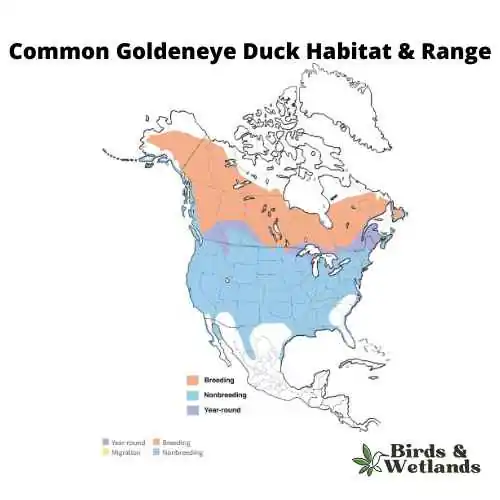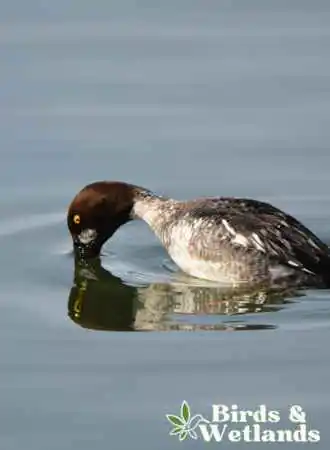
The common goldeneye (Bucephala clangula), also known as the American goldeneye, is a medium-sized diving duck native to North America, northern Europe and East Asia.
The common goldeneye is a strong, agile swimmer and diver who feeds on aquatic insects, crustaceans, and small fish. It is slightly larger than the green-winged teal but smaller than the common merganser. While in flight, its wings make a distinctive whistling sound.
Scientific Name: Bucephala clangula
Length
- Male: 45–51 cm (18–20 in)
- Female: 40–50 cm (16–20 in)
Wingspan: 30.3-32.7 in (77-83 cm)
Weight
- Male: 1,000 g (2.2 lb)
- Female: 800 g (1.8 lb)
Description
Male

The adult male common goldeneye is a medium-sized duck with a dark head and a sloping bill. Its head is iridescent green, often looking black, with a circular white patch at the base of the bill. It is crescent-shaped in Barrow’s goldeneyes.
Its back, rump and uppertail-coverts are black, while its tail is grayish-brown. The neck, upper mantle, breast sides and underparts are white. The inner scapulars are black, while the outer scapulars have black fringes, making them look like they have two shades of color.
When in flight, the wings have dark coverts with white ‘windows’ along the folded wing. The primaries and tertials are also dark in color.
The bill of this duck is entirely black with bright yellow to gold eyes that gave it its name – golden eye. The legs and feet of the common goldeneye are orange-yellow with webbing on them that appear almost black due to their darkness.
Female
The adult female common goldeneye is a medium-sized duck with a stout body and long, pointed wings. Its head is chocolate brown, and its neck is decorated with a whitish band, though this may sometimes be faint.
Its back and wing feathers are slaty grey with white-edged feathers, while the wings feature a pattern similar to the male’s.
The breast, sides, and belly are greyish-brown with individual feathers tipped in white. The bill of the female goldeneye is black with an orange-yellow tip, as well as a black nail at the end.
Its eyes are paler yellow to white, while its legs and feet are orange-yellow with black webs between them.
Listen to the Common Goldeneye
Habitat & Range

The breeding habitat of the common goldeneye is mainly concentrated in the taigas and boreal forests of northern North America. However, smaller populations can also be found in North Dakota, Montana, Minnesota, and the Northeast.
These North American birds prefer to nest in holes in trees close to aquatic habitats such as rivers, wetlands and northern lakes. For suitable nesting sites, these birds seek locations with abundant invertebrate prey, providing good visibility.
Additionally, these ducks have been spotted foraging among bulrush stands during the breeding season.
During winter migrations, these birds will stop to feed on inland lakes and rivers. Their main wintering grounds include coastlines, where they take shelter in protected coastal waters, shallow bays, estuaries and harbors.
These areas have plenty of sand, gravel, rock and boulders hosting mollusks and crustaceans, which aid the birds’ survival through colder temperatures.
It is among the last ducks to migrate south and will winter as far north as ice-free water allows.
Diet & Food Habits

The common goldeneye is a flexible feeder, able to exploit different aquatic habitats, and its diet varies depending on the season and food availability.
During summer, this bird can often be observed foraging in shallow water for plant material such as pondweeds, seeds and roots. It supplements its diet with small mollusks and aquatic invertebrates.
Furthermore, the common goldeneye also feeds on invertebrates like shrimps, crabs, crayfish, amphipods, marine worms and leeches. These are usually caught during dives lasting up to a minute or two. When fishing for small fishes and frogs, it is often seen hovering near the water’s surface before plunging in to make the catch.
During winter, when food sources are more limited or scarce in some areas, they remain active hunters and will feed on whatever prey they can find in ice-free areas in their surrounding habitat.
Despite their opportunistic feeding habits, they exhibit considerable flexibility in what they eat, depending on the availability of food sources. This helps them survive harsh environmental conditions when prey items are scarce.
Nesting & Mating Habits

In North America, the breeding season starts in early March to mid-May.
Males are known for their elaborate courtship displays, such a flicking their head forward while kicking the water. Their courtship call is a loud “jeee-ep” sound. The females utter a soft quack.
The preferred nest sites of the common goldeneye are mature forests with snags or standing dead trees, which provide natural tree cavities for them to lay their eggs.
The females typically build their nests in these cavities of large trees, using broken limbs and large woodpecker holes, particularly those made by pileated woodpeckers. They are also known to lay eggs in nest boxes when available. Interestingly, their nests may also contain eggs of other species, such as those from the hooded mergansers.
During the breeding season, breeding males become increasingly territorial, aggressively defending their nesting sites against intruders.
Adult females build nests out of a depression in wood chips lining the cavity, usually placed between 10 and 15 meters above ground level.
Female common goldeneyes typically lay 8-11 greenish eggs incubated by the female alone for one month before hatching. The male leaves soon after laying to molt with several males in small flocks.
Ducklings are precocial and able to feed themselves shortly after hatching. Still, they are often organized into crèches where they receive additional protection from predators.
Females abandon their chicks shortly after hatching, and the ducklings fledge at around 55-65 days. After fledging, juveniles remain with their crèche until fall migration, when they join flocks of adults to migrate southward for the winter months.
Population & Conservation Status
The Common Goldeneye is currently in a stable population, with an estimated global breeding population of 2.5 million individuals. Despite having a wide range, this species is still considered a low conservation concern.
For the population to remain stable and healthy, successful forestry practices such as leaving dead trees and nest boxes have been used to reestablish populations in areas with few nesting trees.
Additionally, conservation efforts have been put in place to protect wintering sites from loss of coastal and interior wetlands, river channelization, and increased sediment loads due to agricultural and industrial practices that affect foraging areas.
Predation by bald eagles and other birds of prey is also a threat to this duck species. They are also vulnerable to botulism and several species of parasites.
Hunting
Hunting common goldeneye ducks in the U.S. are generally allowed, with some regulations depending on the region. The migration behavior of the duck determines when season opening and closing dates are allocated for hunting different populations.
For best results, hunters in certain areas may want to research the U.S. Fish & Wildlife Service Duck Hunting Regulations to familiarize themselves with specific regulations relevant to their site before attempting a hunt.
Key Points
- Common goldeneyes have large heads, short tails and are cavity-nesters.
- Adult male common goldeneyes are mostly black and white with a slender bill and a golden yellow eye.
- The common goldeneye is named after its golden yellow iris, much like its close relative, the Barrow’s goldeneye.
- Common goldeneyes are diving ducks and strong swimmers, diving to forage underwater food.
- The female has a dark bill with a yellow-orange tip.
- These ducks winter in the southern parts of North America.
- Adult males leave the females during the incubation period.
